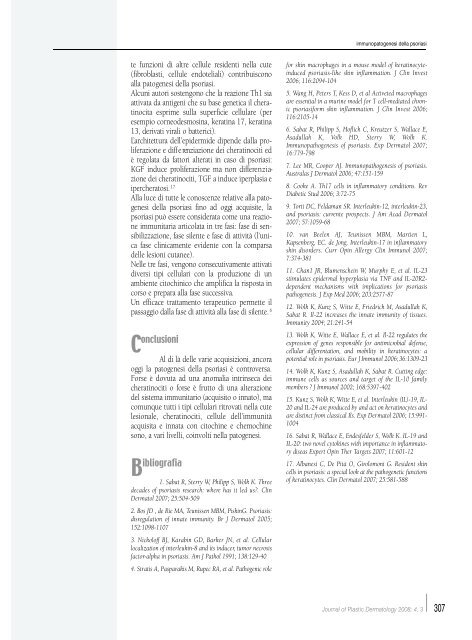N° 3 - Salute per tutti
N° 3 - Salute per tutti
N° 3 - Salute per tutti
Create successful ePaper yourself
Turn your PDF publications into a flip-book with our unique Google optimized e-Paper software.
te funzioni di altre cellule residenti nella cute<br />
( f i b roblasti, cellule endoteliali) contribuiscono<br />
alla patogenesi della psoriasi.<br />
Alcuni autori sostengono che la reazione Th1 sia<br />
attivata da antigeni che su base genetica il cheratinocita<br />
esprime sulla su<strong>per</strong>ficie cellulare (<strong>per</strong><br />
esempio corneodesmosina, keratina 17, keratina<br />
13, derivati virali o batterici).<br />
L’ a rchitettura dell’epidermide dipende dalla proliferazione<br />
e diff e renziazione dei cheratinociti ed<br />
è regolata da fattori alterati in caso di psoriasi:<br />
KGF induce proliferazione ma non diff e re n z i azione<br />
dei cheratinociti, TGF a induce i<strong>per</strong>plasia e<br />
i p e rc h e r a t o s i.<br />
3a<br />
1 7<br />
Alla luce di tutte le conoscenze relative alla patogenesi<br />
della psoriasi fino ad oggi acquisite, la<br />
psoriasi può essere considerata come una re a z i one<br />
immunitaria articolata in tre fasi: fase di sensibilizzazione,<br />
fase silente e fase di attività (l’unica<br />
fase clinicamente evidente con la comparsa<br />
delle lesioni cutanee).<br />
Nelle tre fasi, vengono consecutivamente attivati<br />
diversi tipi cellulari con la produzione di un<br />
ambiente citochinico che amplifica la risposta in<br />
corso e prepara alla fase successiva.<br />
Un efficace trattamento terapeutico <strong>per</strong>mette il<br />
passaggio dalla fase di attività alla fase di silente. 6<br />
o n c l u s i o n i<br />
C<br />
Al di là delle varie acquisizioni, ancora<br />
oggi la patogenesi della psoriasi è contro v e r s a .<br />
Forse è dovuta ad una anomalia intrinseca dei<br />
cheratinociti o forse è frutto di una alterazione<br />
del sistema immunitario (acquisito o innato), ma<br />
comunque <strong>tutti</strong> i tipi cellulari ritrovati nella cute<br />
lesionale, cheratinociti, cellule dell’immunità<br />
acquisita e innata con citochine e chemochine<br />
sono, a vari livelli, coinvolti nella patogenesi.<br />
B ibliografia<br />
1. Sabat R, Sterry W, Philipp S, Wolk K. Three<br />
decades of psoriasis research: where has it led us?. Clin<br />
Dermatol 2007; 25:504-509<br />
2. Bos JD , de Rie MA, Teunissen MBM, PiskinG. Psoriasis:<br />
disregulation of innate immunity. Br J Dermatol 2005;<br />
152:1098-1107<br />
3. Nickoloff BJ, Karabin GD, Barker JN, et al. Cellular<br />
localization of interleukin-8 and its inducer, tumor necrosis<br />
factor-alpha in psoriasis. Am J Pathol 1991; 138:129-40<br />
4. Stratis A, Pasparakis M, Rupec RA, et al. Pathogenic role<br />
immunopatogenesi della psoriasi<br />
for skin macrophages in a mouse model of keratinocyteinduced<br />
psoriasis-like skin inflammation. J Clin Invest<br />
2006; 116:2094-104<br />
5. Wang H, Peters T, Kess D, et al Activeted macrophages<br />
are essential in a murine model for T cell-mediated chronic<br />
psoriasiform skin inflammation. J Clin Invest 2006;<br />
116:2105-14<br />
6. Sabat R, Philipp S, Hoflich C, Kreutzer S, Wallace E,<br />
Asadullah K, Volk HD, Sterry W, Wolk K.<br />
Immunopathogenesis of psoriasis. Exp Dermatol 2007;<br />
16:779-798<br />
7. Lee MR, Coo<strong>per</strong> AJ. Immunopathogenesis of psoriasis.<br />
Australas J Dermatol 2006; 47:151-159<br />
8. Cooke A. Th17 cells in inflammatory conditions. Rev<br />
Diabetic Stud 2006; 3:72-75<br />
9. Torti DC, Feldaman SR. Interleukin-12, interleukin-23,<br />
and psoriasis: currente prospects. J Am Acad Dermatol<br />
2007; 57:1059-68<br />
10. van Beelen AJ, Teunissen MBM, Martien L,<br />
Kapsenberg, EC. de Jong. Interleukin-17 in inflammatory<br />
skin disorders. Curr Opin Allergy Clin Immunol 2007;<br />
7:374-381<br />
11. Chan1 JR, Blumenschein W, Murphy E, et al. IL-23<br />
stimulates epidermal hy<strong>per</strong>plasia via TNF and IL-20R2dependent<br />
mechanisms with implications for psoriasis<br />
pathogenesis. J Exp Med 2006; 203:2577-87<br />
12. Wolk K, Kunz S, Witte E, Friedrich M, Asadullah K,<br />
Sabat R. Il-22 increases the innate immunity of tissues.<br />
Immunity 2004; 21:241-54<br />
13. Wolk K, Witte E, Wallace E, et al. Il-22 regulates the<br />
e x p ression of genes responsible for antimicrobial defense,<br />
cellular diff e rentation, and mobility in keratinocytes: a<br />
potential role in psoriasis. Eur J Immunol 2006; 36:1309-23<br />
14. Wolk K, Kunz S, Asadullah K, Sabat R. Cutting edge:<br />
immune cells as sources and target of the IL-10 family<br />
members ? J Immunol 2002; 168:5397-402<br />
15. Kunz S, Wolk K, Witte E, et al. Interleukin (IL)-19, IL-<br />
20 and IL-24 are produced by and act on keratinocytes and<br />
are distinct from classical Ils. Exp Dermatol 2006; 15:991-<br />
1004<br />
16. Sabat R, Wallace E, Endesfelder S, Wolk K. IL-19 and<br />
IL-20: two novel cytokines with importance in inflammatory<br />
diseas Ex<strong>per</strong>t Opin Ther Targets 2007; 11:601-12<br />
17. Albanesi C, De Pità O, Girolomoni G. Resident skin<br />
cells in psoriasis: a special look at the pathogenetic functions<br />
of keratinocytes. Clin Dermatol 2007; 25:581-588<br />
Journal of Plastic Dermatology 2008; 4, 3<br />
307

















